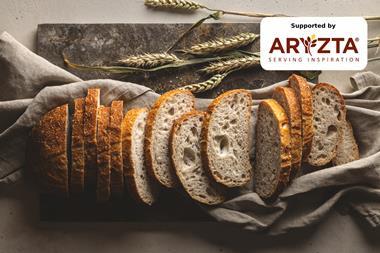Will we be tucking into our full English breakfasts on a stuffed crust? The pizza-for-breakfast trend from the US appears to be gaining traction in the UK
A fair number of British Baker readers will have woken up – and possibly sobered up – to a breakfast of last night’s pizza.
And while no-one is likely to build a business around cold slices of cheese and tomato on a stale crust, the idea of offering hot, fresh pizza as a breakfast option is fast gaining traction. According to Kara Foodservice, part of Finsbury Food Group, breakfast pizzas could be the next big trend for the food industry.
“With the growing popularity of brunch, this has led to the introduction of new menu items in the foodservice arena, one being breakfast pizzas,” says Kara marketing manager Jane Deegan.
The potential of breakfast pizza is down to a variety of factors, one being the speed and ease of the dish. With food-to-go expected to soar by 71% in the next five years (The Food People), breakfast pizza is the ideal grab-and-go morning meal, adds Deegan.
Breakfast pizzas can tap the trend of consumers shifting to a more flexible pattern of eating, as discussed in a recent study by market research provider Euromonitor International. Analysts found that the line between snacking and breakfast is blurred for many consumers, who increasingly grab a quick bite on the move.
Breakfast is a meal that is often “skipped, eaten on the go or consumed while performing other tasks,” says Euromonitor International strategy briefings director Gina Westbrook.
Italian chain Bella Italia already sells a Breakfast Pizza for £10.29 at London’s Luton airport. The pizza is topped with bacon, Cumberland pork sausages, tomatoes, mushrooms and a fried egg.
Pizza manufacturer Pan’Artisan tells British Baker the growing interest in breakfast pizza has filtered through from the US, where hot breakfast pizzas are sold through retailers including the 7-Eleven chain of convenience stores.
A recent report by foodservice analysts Technomic on the US convenience market shows the number of pizza items on morning menus has increased by more than 15% year on year, according to Stuart Jackson, director of sales at Pan’Artisan. Technomic’s MenuMonitor menu-tracking data also shows 55% of foodservice consumers are attracted to the addition of breakfast pizzas on morning menus, while 42% of 18- to 34-year-olds order pizza from convenience stores at least once a month.
Meanwhile, US business magazine Forbes flagged up breakfast pizza as one of the food trends of 2017.
Supplier Ornua Ingredients UK says the pizza format could offer a quicker and easier way to consume a cooked breakfast.
“Breakfast pizza is the latest addition to the growing options available to a nation determined to make the first meal of the day every bit as interesting and enjoyable as the traditional ‘main’ dining occasions,” says Ornua market development director Richard Thorpe. “Hot, tasty, versatile, flexible, and portioned to just the size we want… could there be a quicker or easier way to have a cooked breakfast offering everything from the classic toppings to a ‘full English’ starring eggs, bacon, sausage and tomato?”
Thorpe points out that pizza recipes can also be adapted to appeal to the growing number of vegetarian and flexitarian consumers in the UK.
Onions, tomatoes and mushrooms are great vegetarian options for breakfast pizza, according to CSM Bakery Solutions’ market leader for bread ingredients Miriam Bernhart, who adds that breakfast pizza could even help to reduce waste for bakers.
“Bakers who are offering pizzas for the lunchtime trade can use the same mix to capitalise on sales during the breakfast period as well. This is a great way to reduce waste and make the most of the trend for unusual hot breakfasts,” says Bernhart. “Consumers are increasingly looking for something unusual for breakfast and pizzas work well as they can be grabbed on the go for those in a rush.”
CSM has also offered tips to help bakers thinking about selling breakfast pizzas:
- Ensure the range is visible in-store throughout the mornings to drive impulse purchases and help customers make their choice.
- Cook pizza fresh on site to create a delicious smell and don’t forget to advertise the range in-store and out-of-store with menu boards.
- Sell pizzas along with an orange juice, tea or coffee to encourage customers to turn it into a morning meal.
The pizza market is currently missing out on the growing number of people, especially millennials, going out for brunch at the weekend, according to Claire Nuttall, founder of The Brand Incubator.
“Breakfast or brunch pizzas could be a good way to extend usage occasions and frequency of consumption of pizza as a choice both in and out of home,” she says.
Nuttall suggests there is an opportunity to change the types of dough suppliers use to suit the breakfast market, such as switching to sourdoughs or seeded options.
“Thinking about what people often eat for breakfast – bacon, eggs, cheese, tomatoes – these are key aspects of a traditional pizza, so it should not really feel that alien at all,” she adds. “More fashionable takes on breakfast, such as avocado and crispy pancetta with chilli flakes, could also work as pizza. The choice of toppings and bases will make the difference to breakfast pizzas feeling an acceptable choice.”
One potential stumbling block for breakfast pizzas are health concerns, with pizza and other savoury snacks set to come under pressure from health chiefs. In August, Public Health England widened its focus from sugar to total calories, stating that excess calories – not just excess sugar consumption – was the reason a third of children leave primary school overweight or obese. PHE is to consult with the food industry and related groups to develop guidance and timelines for a calorie reduction programme.
Yet it is possible to develop breakfast pizzas that provide nutritional value, according to Davide D’Auria, recently appointed as technical sales and development manager at Eurostar Commodities. He stresses, however, that there are many things to consider when tapping the breakfast market with healthier pizza products.
“A bakery should consider market features and audience preference. On top of that, [consideration should be given to] the redesign of the pizza as a product to fit the first meal of the day; thinking about what should be eaten at breakfast,” D’Auria tells British Baker.
“It should contain a greater level of fibre and cereal. There are flours that would allow us to create a great product, offering a low level of gluten and a high level of fibre and vitamins such as spelt and rye, vegetable flours or sprouted flours.”
He adds: “It’s proof that the pizza, as a product, needs to be bespoke to what is needed at this time of the day, rethinking the recipe and implementing good ingredients.”
One issue breakfast pizza could face is Brits’ conservative attitude to established foods, suggests Jonny Bingham, director at food developer Bingham & Jones. “Most people will be fairly happy to eat the remains of last night’s pizza for breakfast, but a specific breakfast pizza feels like it crosses an invisible line into weirdness for some,” he adds. “I think it would take something really special to break the market open.”
While breakfast pizzas may not be everyone’s cup of tea, they could be an opportunity for bakers looking for their next gap in the market.
Free-from pizza adapts to changes in consumer demand
Pizza suppliers have adapted ranges to attract the growing number of Brits adopting vegetarian, flexitarian and even vegan diets.
Among these are gluten-free brand White Rabbit Pizza Co, which recently secured listings in Sainsbury’s with its chilled vegan pizza .Topped with vegan cheese, peppers and olives, the Smokin’ Vegan (pictured right) is available in 150 Sainsbury’s stores nationwide, priced at £4.99.
“We were incredibly flattered not only by the fact Sainsbury’s contacted us regarding the range, but also by their wonderful feedback on the products themselves,” says White Rabbit co-founder Nick Croft-Simon.
Also tapping the market is One Planet Pizza, which produces ready-made frozen pizza.
“We started selling to just one small shop in Norwich. We are now selling to 60 stores in the UK and have just broken into two wholesalers,” Joe Hill, co-director of One Planet Pizza tells British Baker.
“We are rapidly growing and expect to be selling our pizzas to 100 stores in the next six months.”
Hill turned vegan two years ago, and created the business shortly after, with his father Mike.
“We have our cheese supplied by Bute Island Foods, which I believe is the oldest vegan cheese-maker in the UK, based in Scotland,” he explains. “They produce their cheeses using coconut, which is incredible.”
Hill says the popularity of its vegan pizzas is continuing to grow and that he plans to expand its four-strong range.
“We will be moving into new premises soon and have three products in mind at the moment, including a gluten-free vegan pizza option,” adds Hill.
’Full English’ pizza recipe
Ingredients (serves 4)
Pizza dough
- Tipo 00 flour, 1kg
- Salt, 1 tbsp
- Caster sugar, 1 tbsp
- Olive oil, 4 tbsp
- Fresh yeast, 30g or dried yeast, 14g
- Tepid water, 650ml
Topping
- Chopped tomatoes, 200g
- Tomato purée, 1 tbsp
- Salt and pepper
- Chipolata sausages, 8
- Thin streaky bacon or pancetta, 8 pieces
- Baby plum tomatoes, 8, sliced in half
- Boudin noir, 200g, sliced into 8 pieces
- Chestnut mushrooms, 250g, sliced
- Olive oil, 1 tbsp
- Quail eggs, 8
Method
For the pizza dough
- Place flour into a mixing bowl and add salt, sugar and olive oil. Knead with a dough hook.
- Mix the sachets of yeast into the tepid water and whisk until dissolved. Slowly pour the yeast mixture into the mixing bowl while kneading and continue to knead – after 5 minutes the dough should be smooth and springy.
- Remove dough hook, dust top of dough with flour and cover with a cling film or cloth; leave for 1 hour in a warm room until the dough has doubled in size.
- Place the dough onto a floured surface and knead again. Divide it into three pieces – one is sufficient enough for the pizza, and freeze the rest for next time.
For the ‘full English’ pizza
- Preheat oven to 225°C.
- Brush a large flat tray (30 x 33cm) with some olive oil and roll out the pizza dough to the size of the tray; stretch the dough into the corners if very springy.
- Make a passata by blending the chopped tomatoes and the tomato purée together in a food processor and season to taste.
- Spread passata over the pizza dough, leaving a 10mm gap at the edge of the pizza.
- Pan-fry the sliced chestnut mushrooms and chipolatas in with the olive oil until golden brown, then transfer the chipolatas to the oven for 5 minutes.
- Scatter the mushrooms, halved baby plum tomatoes, sliced boudin noir and pancetta over the pizza and place into the oven.
- After 4 minutes, add chipolatas and crack quail eggs onto the pizza and cook for a further 2 minutes.
- When cooked, transfer to a large board and serve.
Source: Reynolds
New artisan pizza flours
Eurostar Commodities is ramping up its activity in the artisan pizza flour market with a new range.
The firm, which supplies ingredients including chapati, pasta and vegetable flours, is rolling out new Eurostar pizza flours, made from beetroot, spinach and sweet potato.
It is also the UK’s exclusive distributor of flours from Grandi Molini Italiani. The line comprises: Pizza Verace, described as “extraordinarily digestible”, with a golden crust; Pizza Italiana, a type ‘00’ flour, described as fragrant and particularly good for deep-dish; Lievito Naturale, a natural yeast type ‘0’ malted wheat flour, to increase extensibility; and Pizza Dorata, produced with Manitoba grain and a mix of Canadian and North American grains.
Revealed: top of the toppings
Mushrooms are the top choice for pizza toppings among UK consumers, acccording to a YouGov study conducted this year.
Nearly two-thirds of Brits (65%) enjoy mushroom on their pizzas, while 61% prefer ham. Least desirable toppings were tuna (22%) and anchovy (18%).
Researchers found men are much more likely than women to like meat on their pizza, while women are more likely to pick vegetarian options such as spinach. Meanwhile, the older generation prefer mushrooms and tomatoes as a topping, while youngsters enjoy chicken, pepperoni, sweetcorn and pork.
YouGov also asked consumers which pizza toppings they would like banned – top of the list was anchovies, followed by olives, and then tuna.


























No comments yet